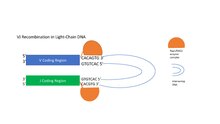|
Recombination signal sequencesRecombination signal sequences are conserved sequences of noncoding DNA that are recognized by the RAG1/RAG2 enzyme complex during V(D)J recombination in immature B cells and T cells.[1] Recombination signal sequences guide the enzyme complex to the V, D, and J gene segments that will undergo recombination during the formation of the heavy and light-chain variable regions in T-cell receptors and immunoglobulin molecules.[1] StructureRSSs are made up of highly conserved heptamer sequences (7 base pairs), spacer sequences, and conserved nonamer sequences (9 base pairs) that are adjacent to the V, D and J sequences in the heavy-chain region of DNA and the V and J sequences in the light-chain DNA region.[1][2] Spacer sequences are located between heptamer and nonamer sequences and exhibit base pair variety but are always either 12 base pairs or 23 base pairs long.[3] Heptamer sequences are usually Function The RAG1/RAG2 enzyme complex recognizes the heptamer sequences flanking the V and J coding regions and nicks their 5' end, releasing the intervening DNA between the V and J coding regions.[1] In the heavy-chain coding region of DNA, the RAG1/RAG2 enzyme complex recognizes the RSSs flanking the D and J segments and brings them together, forming a loop containing intervening DNA.[1][4] The RAG1/RAG2 complex then introduces a nick at the 5' end of the RSS heptamers adjacent to the coding regions on both the D and J segments, permanently removing the loop of intervening DNA and creating a double-stranded break that is repaired by VDJ recombinase enzymes.[1][4] This process is repeated for the joining of V to DJ.[1] In light-chain rearrangement, only V and J segments are brought together.[1] Related Diseases & DisorderscRSSCryptic RSSs are gene sequences that resemble authentic RSSs and are occasionally mistaken for them by the RAG1/RAG2 enzyme complex.[3] Recombining an RSS with a cRSS can lead to chromosome translocations, which can lead to cancer.[3] Omenn's SyndromeSome infants born with autosomal recessive SCIDS lack a functional copies of the genes that code for the RAG1/RAG2 enzyme complex because of missense mutations.[5][6] These infants will produce a non-functional RAG1/RAG2 enzyme complex that cannot recognize RSSs and therefore cannot initiate V(D)J recombination effectively.[5][6] This disorder is characterized by a lack of functioning B and T cells.[1][5] References
|